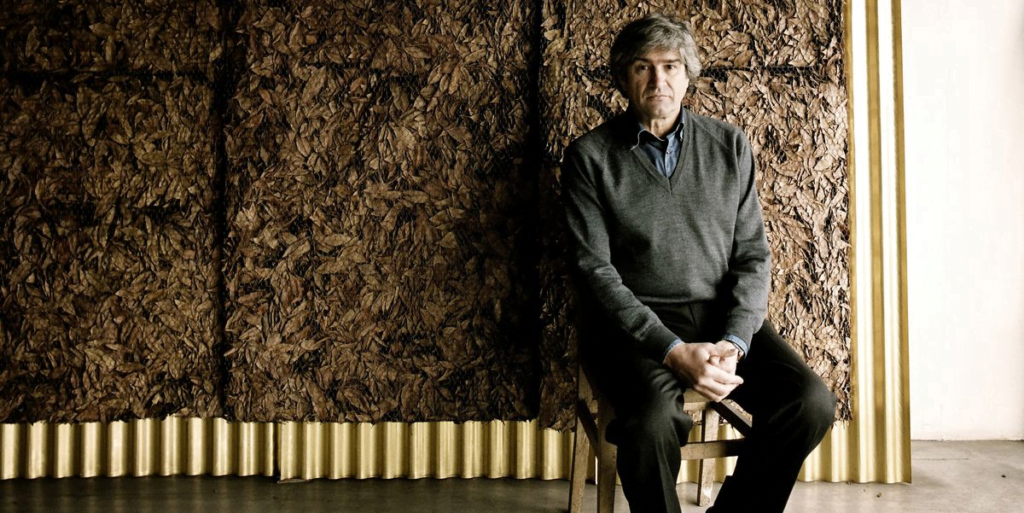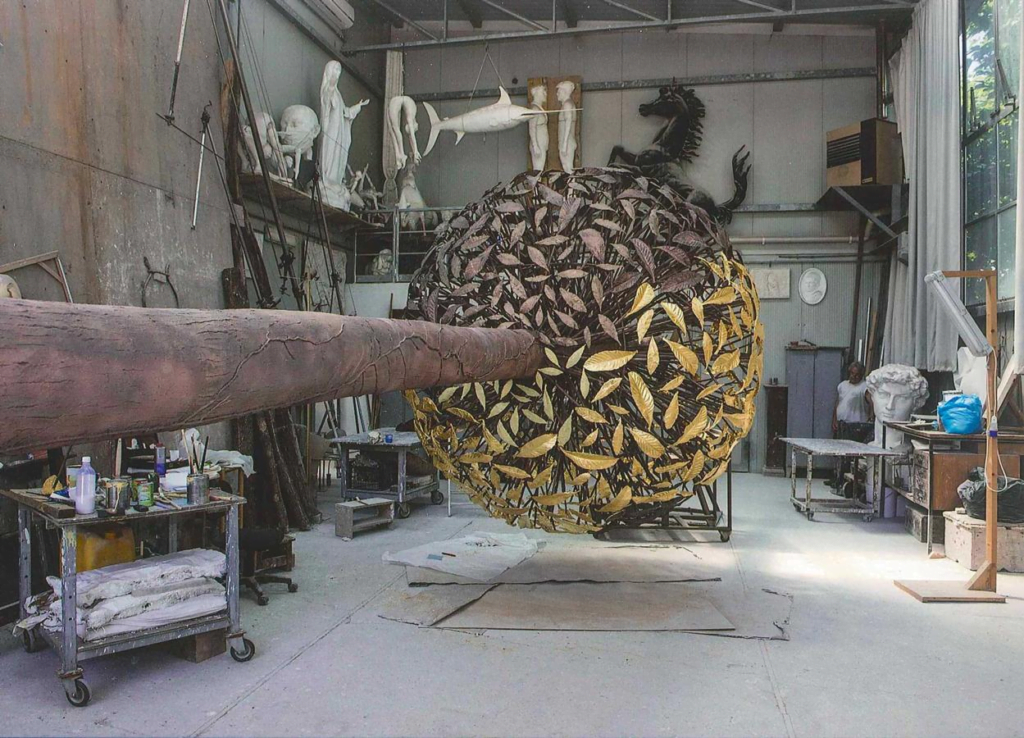Giuseppe Penone BIOGRAPHY

Early Life and Inspiration: Penone’s Upbringing in Rural Italy
Penone grew up in rural Garessio, Italy, surrounded by forests that inspired his art. His father was a farmer, exposing Penone to nature from an early age.
Childhood and the Discovery of Art
Penone discovered art as a child through religious paintings and sculptures in local churches. Their emotional intensity and lifelike quality struck him. Penone’s early experiences cultivating the land and observing natural growth influenced his artistic philosophy.
Penone moved to Turin in 1960 to study at the Accademia Albertina. There, he connected with artists questioning traditional art forms. Penone began using natural materials like wood, leaves, and stones in conceptual works that explored growth and the relationship between humans and nature.
Experimentation and Development of Style
In the late 1960s, Penone created his first growth sculptures. For a piece titled “Tree, 1968,” he moulded a sapling around a metal armature to shape its growth. This fusion of nature and human intervention became a hallmark of Penone’s oeuvre.
Penone was associated with the Arte Povera movement, though he refuted categorization within any specific genre. His works aimed to strip art of bourgeois excesses, using humble organic materials and a minimalist style to highlight humanity’s connection to the natural world. Penone strove to reveal the primordial essence of materials to evoke eternal themes of life, death, and regeneration.
What is Giuseppe Penone known for?

Penone’s pioneering art has explored the endless nuances of growth and our relationship with nature through sculpture, installation, drawing, and performance. His childhood in rural Italy instilled a lifelong curiosity about natural processes that he spent decades thoughtfully translating into poetic works of art.
Career highlights

Early Works
Childhood experiences inspired Penone’s earliest works in the foothills of the Italian Alps. He utilized natural materials such as stones, branches and leaves in his sculptures to represent growth and human connection to nature.
In his first solo exhibit, “La Scultura Lingua Morta” (“Sculpture Dead Language”) in 1968, Penone unveiled 12 of these organic sculptures that challenged traditional notions of the art form.
Around this time, Penone became associated with the Arte Povera (“Poor Art”) movement. Like other artists in this avant-garde group, Penone aimed to push the boundaries of contemporary art by using unconventional, often ephemeral materials in conceptual works. His sculptures from this era focused on themes of growth, physicality and humanity’s relationship with nature.
For example, in “Reverse Your Eyes” (1970), Penone traced the outline of his face and hand on a sheet of paper and then planted saplings within these contours. As the trees grew, they distorted the shapes, symbolizing the passage of time.
Penone’s innovative works caught the attention of renowned art critics and curators early on, leading to collaborations and exhibits that brought international recognition. Though associated with Arte Povera, Penone’s style evolved over decades into a conceptual genre of its own. His sculptures, drawings and other works have been featured in major museums worldwide, establishing Penone as a pioneer in contemporary art.
Founding Arte Povera: Penone’s Role in the Radical Art Movement
In the late 1960s, Penone and other Arte Povera artists sought to counter the commercialization of art. They turned away from traditional, expensive art materials and instead utilized natural, “impoverished” materials like soil, wood, stones and leaves. For Penone, this meant engaging directly with nature through actions like grasping tree branches, scattering leaves and revealing the inner layers of tree trunks. Penone and the other Arte Povera artists aimed to reconnect art and life by fusing conceptual concerns with natural materials and processes.
Giuseppe Penone List of Work

Mature Works and Artistic Themes: Penone’s Exploration of Nature and the Human Body
Penone explores themes of nature, the human body, and humanity’s relationship with the natural world in his mature works. His large-scale sculptures and installations utilize raw materials like wood, stone, and metal to represent growth, physicality, and the passage of time.
“The Hidden Life Within” | 2008 | This work consists of a large block of marble containing a negative space in the shape of a tree trunk. The interior of the marble is intricately carved to resemble growth rings and knots in the wood. This striking piece renders the inner life of the tree visible, representing the complex history and temporal depth within natural forms. |
“Palpebre (Eyelids)” | 1970-1980 | This sculpture features two large slabs of wood propped upright with ropes and pulleys. Carved into the wood are shapes resembling human eyelids, which open and close as the wood expands and contracts based on humidity and temperature changes. This work suggests a shared vitality between the human body and nature. |
Penone’s art explores profound ideas about life, time, and humanity’s relationship with nature. By uncovering and highlighting the hidden depths within natural materials and forms, Penone renders life’s most essential qualities visible.
His ability to find connections across scales, from the minute details of growth rings to the grand themes of life and death, gives his work a poetic resonance and philosophical power. Penone’s art reminds us of the shared materiality between all things and our ultimate connection to the natural world.
Recent Exhibitions and Accomplishments: Celebrating Penone’s Pioneering Career
Over the past decade, Giuseppe Penone’s groundbreaking art has been celebrated through major exhibitions and accolades around the globe. His influential works have spanned over 50 years, establishing him as a pioneer of the Arte Povera movement.
2013 | Whitechapel Gallery in London | The exhibition spanned five decades of his career and was praised by critics as “a revelation of his poetic vision.” That same year, Penone was awarded the prestigious Japanese Praemium Imperiale prize for sculpture. |
2015 | Center Pompidou in Paris | The massive exhibit featured over 200 creations that highlighted his experimental and multidisciplinary approach. Reviewers lauded the show as “a journey through a half-century of creation by one of the major artists of our time.” Penone donated several pieces from the exhibition to the Pompidou. |
2016 | Venice Biennale | Penone represented Italy creating an immersive installation of sculptures and drawings in the Italian Pavilion. The following year, the Palazzo Strozzi in Florence, Italy organized another major retrospective titled “The Hidden Life Within,” showcasing Penone’s artistic evolution and relationship with nature. |
2019 | Pirelli HangarBicocca in Milan | The show was described as a “total immersion in the artist’s poetics” by occupying the entire museum space. |
At over 80 years old, Penone continues pushing contemporary art’s boundaries through his timeless and thought-provoking creations. His pioneering vision and masterful works have cemented his status as one of the most influential artists of our time.

